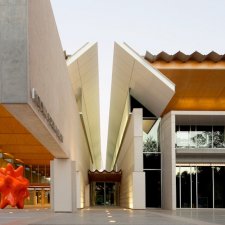- About us
- Support the Gallery
- Venue hire
- Publications
- Research library
- Organisation chart
- Employment
- Contact us
- Make a booking
- Onsite programs
- Online programs
- School visit information
- Learning resources
- Little Darlings
- Professional learning
Rhys Maengwyn Jones (1941-2001), archaeologist and academic, grew up in Wales and studied at Cambridge before taking up an appointment at the University of Sydney in 1963. Five years later he moved to the Australian National University, where he was to remain until 2001, holding a personal chair from 1993. Although he worked with DJ Mulvaney and Jim Bowler at the profoundly significant site of Lake Mungo in the late 1960s, he is best known for his research in Tasmania, which put paid to myths about separate origins for Tasmanian and mainland Aborigines. In 1977 he collaborated with filmmaker Tom Haydon on the documentary The Last Tasmanian, which, though controversial, emphasised the genocidal brutality of colonists toward the Indigenous Tasmanians. From the early 1970s he studied (with Betty Meehan) the Anbarra people of Arnhem Land, writing on a host of topics including hunting techniques, watercraft, colour concepts, Indigenous science and traditional uses of fire in land management (‘cleaning up country’). Jones has been credited with a vital role in raising national consciousness of the antiquity of Indigenous populations, the complexity and sophistication of their adaptation to the Australian continent and the tragedy of their displacement. A quotation from an article by Jones accompanies Janet Laurence’s and Fiona Foley’s sculptural installation The Edge of the Trees outside the Museum of Sydney: ‘The discoverers struggling through the surf were met on the beach by other people looking at them from the edge of the trees. Thus the same landscape perceived by the newcomers as alien, hostile or having no coherent form, was to the Indigenous people their home, a familiar place, the inspiration of dreams.’
Collection: National Portrait Gallery
Gift of Betty Meehan 2013
© Rhodri Glyn Davies
Betty Meehan (1 portrait)



On one level The Companion talks about the most famous and frontline Australians, but on another it tells us about ourselves.



Visit us, learn with us, support us or work with us! Here’s a range of information about planning your visit, our history and more!



We depend on your support to keep creating our programs, exhibitions, publications and building the amazing portrait collection!